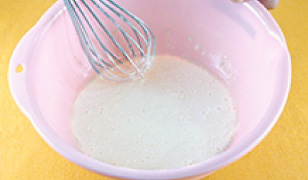Discovering Okonomiyaki
Okonomiyaki was invented in Japan before World War II and evolved, becoming popular during and after the war. The earliest origins of this basic crepe-like pancake date back to the Edo period (1683-1868), where it was a special dish served during Buddhist ceremonies called Funoyaki.


Okonomiyaki, one of Japan's famous dishes (also street food)
Okonomiyaki was invented in Japan before World War II and evolved into a popular dish during and after the war. The earliest origins of this basic crepe-like pancake date back to the Edo period (1683–1868) where it was a special dish served during Buddhist ceremonies called Funoyaki.
This then evolved during the Meiji period (1868–1912) into a sweeter dish called Sukesoyaki. During the 1920s and 1930s the dish continued to evolve with greater emphasis on added sauces and the name Yoshokuyaki began to be used.
The name Okonomiyaki originated in Osaka in the late 1930s. A crepe-like dish was popular in Hiroshima at the time: it was stuffed with onions, folded, and served to children as a snack. Okonomiyaki, in its various variations, began to become more popular during the war when rice became scarce and residents had to be creative in using other, more readily available ingredients. The simple wheat flour pancake suited the context, and during and after the war, people began adding more ingredients such as eggs, pork, and cabbage. One Osaka restaurant claims to have been the first to add mayonnaise in 1946.

There are basically two variations of okonomiyaki: Kansai-style okonomiyaki is made by mixing the ingredients and batter before cooking, while Hiroshima-style okonomiyaki is made by cooking the batter and ingredients in layers without mixing them on the griddle. In addition to these two popular versions, similar dishes are found in other parts of the country.
The word "okonomiyaki" comes from "okonomi," meaning "as you like," and "yaki," meaning "grilled." It's commonly referred to as a Japanese pancNagaimo / Yamaimoke. True to its name, okonomiyaki can be served with a variety of toppings, including everything from meat and seafood to vegetables and cheese. Okonomiyaki is typically served with a special sauce, Japanese mayonnaise, nori, and bonito flakes.

The recipe for making okonomiyaki is quite simple and the result you get is truly very satisfying but to make a really really good okonomiyaki, there are some ingredients that are necessary if not fundamental and what you get in the end tastes much better than those that do not include them.

Nagaimo / Yamaimo
It's a Japanese long yam (nagaimo) or mountain yam (yamaimo), and I think it's the most important ingredient, so your okonomiyaki doesn't get too mushy. You'll need to grate the yam. Raw grated yam is very slimy, but when cooked, it helps the okonomiyaki become nice and fluffy.

Tenkasu (tempura pieces/scraps)
This is another ingredient that makes the batter fluffier. Many people in Osaka say this is one of the most important ingredients, next to nagaimo/yamaimo. You can make your own tempura scraps using leftover batter. All you need to do is drop the batter into the hot oil and scoop it out when golden brown.

Okonomiyaki Sauce
The taste of okonomiyaki depends heavily on the sauce. This sauce is truly unique in both taste and texture, and without it, okonomiyaki would not exist.

Japanese mayonnaise
The Osaka specialty, whether takoyaki or okonomiyaki, features splashes of mayonnaise along with the sweet and savory takoyaki/okonomi sauce. Incredibly smooth and creamy, Japanese mayonnaise is slightly different from Italian or American mayonnaise.

Katsuobushi
It's a super umami-rich ingredient that we use to make dashi (the Japanese stock for miso soup and all kinds of Japanese dishes). These flakes are so thin—when you sprinkle them on top of okonomiyaki, they dance with the steam!

Aonori
This umami-rich seaweed has a bright, deep green color and a unique aroma.
Then add the common ingredients such as benishoga (a particular slightly spicy ginger), eggs, dashi broth, bacon and spring onion (as a substitute we also recommend chives) and of course the cabbage.

How to make okonomiyaki
Instructions and ingredients for 2 servings:
o simple flour: 80 g
o granulated dashi: 2g
o water: 100cc (in which to dissolve the granulated dashi)
o grated yam: 30 g
o roughly chopped cabbage: 300 g
o green onion, chopped into small pieces: 10 g
o pork belly: 80 g (3 slices per serving)
o eggs: 2 pieces
o tenkasu: 20 g
o benishoga: 30 g
o aonori seaweed: q.b.
o otafuku sauce: 120 g
o mayonnaise: 90 g
|
|
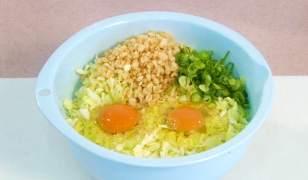 |
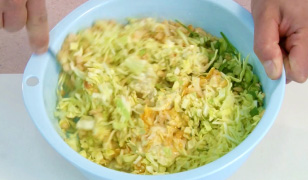 |
| Add the flour, yam, and dashi stock granules to the water and mix well. | Place the cabbage, tenkasu, spring onion, and benishoga in a bowl and add the eggs on top. | Mix evenly with a spoon to incorporate air. |
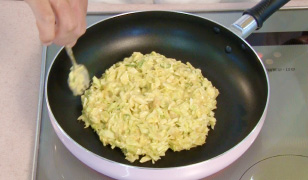 |
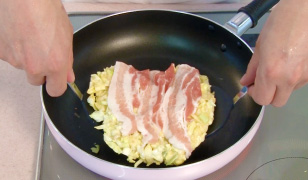 |
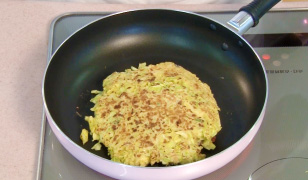 |
| Pour the mixture into a non-stick pan, spread it out with the edges of a spoon to a thickness of about 2 cm and cook for about 3 minutes. | After about 3 minutes, place 3 slices of pork belly on the dough. | Turn it over. |
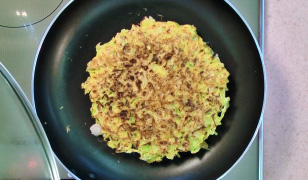 |
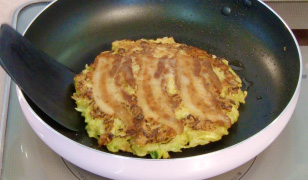 |
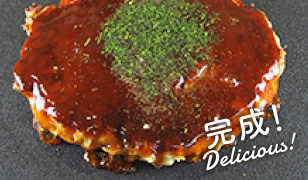 |
| Cover with a lid and continue cooking for about 4 minutes. | Remove the lid, turn again and cook for another 3 minutes. | Drizzle with okonomiyaki sauce and mayonnaise (not pictured) and sprinkle with green aonori seaweed. |








